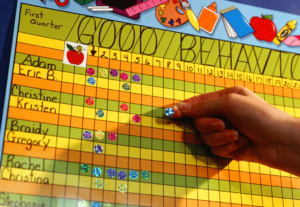Behaviour Management Strategies in Primary Schools
Classroom management is a crucial aspect of creating a positive learning environment in any educational setting. Whether you’re an experienced teacher or just starting your career, implementing effective behaviour management strategies is a must for supporting learning whilst reducing poor behaviour.
In this blog post, we’ll explore key ideas from experienced educators and experts to help you navigate the challenges of classroom behaviour.

1. Stick to the Behaviour Policy:
Adhering to the school’s behaviour policy is the cornerstone of effective behaviour management, and cutting out disruptive behaviour.
Consistency is key, and positive reinforcement plays a vital role in reminding students of expectations. Utilize the warning and sanction system outlined in the policy when necessary to maintain order in the classroom. This should
include your own primary classroom rules. These class rules may include 1. Always try our best, 2. Alway listen carefully, 3. Always be respectful to each other.
2. Positive Behaviour Management at the Start of the Lesson:
Establishing a structured beginning to each lesson sets the tone for positive behaviour. Consider the following steps:
- Manage entry by standing at the door and allowing students in one at a time.
- Introduce a ‘Do Now’ activity to engage students immediately upon entry.
- Display the seating plan and insist on students sitting in allocated seats.
- Provide positive reinforcement for students making good choices at the start of the lesson.
3. Plan for all Transition Points in Lessons:
Anticipate transition points within lessons and plan activities accordingly to maintain a smooth flow. These are common areas where disruptive behaviour can present, for example when handing out resources or moving room.
Displaying information progressively on slides can help manage students’ focus and pace. Address potential issues, such as late arrivals or unfinished tasks, with proactive solutions to prevent disruptions.

4. Address the Class Positively:
The power of body language in addressing the class cannot be overstated. Standing and positioning yourself assertively ensures students understand the importance of paying attention. Positive language and consistent body language contribute to a conducive learning atmosphere.
5. Plan Ahead for Potential Issues:
Proactive planning for potential issues is a hallmark of effective behaviour management. Consider scenarios like late arrivals or students struggling to finish tasks and have strategies in place.
Open-ended ‘Do Now’ activities and clear instructions can help alleviate disruptions.

Online Behaviour Management Courses
Introduction to Behaviour Management
Positive Behaviour Management for Teachers
Positive Behaviour Management for Teaching Assistants
Positive Behaviour Management for Supply Teachers
Behaviour Management Strategies from Experienced Teachers:
1. Use the CASPER Approach:
The CASPER approach – Calm, Assertive, Status preservation, Empathy, and Respect – provides a structured method for approaching and dealing with behaviour management. This approach encourages maintaining authority, understanding students’ feelings, and reinforcing expectations through respectful interactions.
Student should start to take responsibility for their own behaviour.
2. Establish a Countdown Routine:
Implement a countdown system to signal transitions, allowing students time to finish tasks and prepare for the next instruction. This polite approach promotes a sense of fairness and cooperation among students.
3. Reward Good Behaviour and Reprimand Challenging Behaviour:
Strike a balance between rewards and sanctions to motivate and penalize students when necessary. Check with the school for consistent approaches and ensure alignment with policy. Detentions, praise, and small treats can be effective tools in managing behaviour.
4. Set Clear Expectations:
Clearly define rules, guidelines, and expectations in the classroom. Establish ‘house rules,’ outline repercussions for not following them, and reward consistent appropriate behaviour. A transparent set of rules contributes to a well-managed and structured learning environment.
Mastering student behaviour management strategies is an ongoing process that requires adaptability and proactive planning.
By incorporating these insights, you can create a positive and productive learning environment that supports both students and teachers in achieving success. Remember, the key is consistency and a commitment to fostering a positive classroom culture.
Would you like career support? Are you looking for a new role?
You can view all our latest school vacancies here. Alternatively, register your interest here.
Teaching Blog
No results found.....